Google Bard Statistics For 2024 (Beyond Google Search)
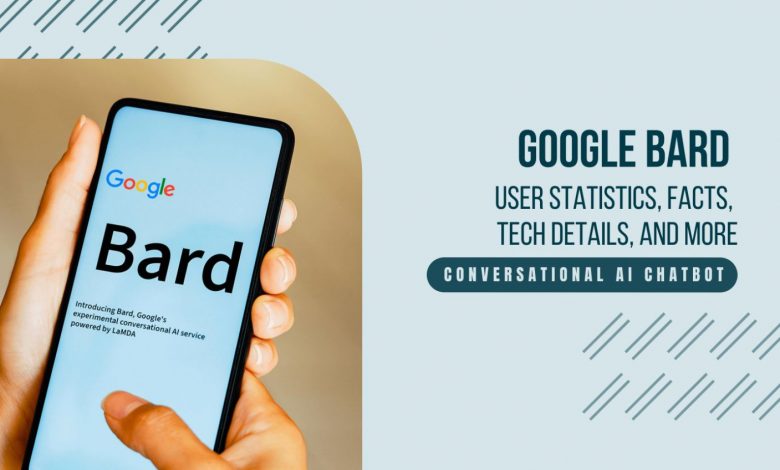
Google Bard is a conversational AI chatbot developed by Google AI. It’s designed to be informative and comprehensive in its responses, going beyond simply providing links like a regular search engine.
Bard can tackle a wide range of questions, from factual queries to open-ended ones. It draws on its vast knowledge base to provide accurate and informative answers. Unlike regular search results, Bard aims to understand the context behind your question and deliver a tailored response, avoiding information overload.
- Engaging in conversation:
Bard isn’t just a question-answering machine. It can hold natural conversations, discuss ideas, and even tell jokes. Think of it as a chatty and knowledgeable friend. It’s trained on real-world dialogue data, allowing it to understand and respond to your queries in a conversational way.
- Generating different creative text formats:
Bard can be your creative partner, generating different content formats like poems, code, scripts, musical pieces, emails, letters, etc. If you have a specific need or style in mind, Bard can adapt its output to fulfill your requirements.
Read through this blog post for all latest and trending Google Bard statistics.

Ready to get fascinated by the new Google Bard?
Table of Contents
Google Bard Statistics (Editor’s Pick)
History of Google Bard (Timeline)
Google Bard Statistics: Overview
Is Google Bard Free?
Google Bard User Demographics Statistics
How Many Languages Google Bard Supports?
General Google Bard Facts and Statistics
Limitations of Bard
How To Export Responses from Bard?
Google Bard Advantages
How To Use Google Bard A Guide to Maximizing its Potential
Other Interesting Bard Features
Google Bard: Shaping the Future of AI Search
The Road Ahead for Google Bard
Google Bard Statistics – (Editor's Pick)
|
History of Google Bard (Timeline)
| Month | Milestone/Improvement | Description |
|---|---|---|
| Jan 2024 | Export Functionality | Bard introduces table export functionality, allowing users to directly export query results to Google Sheets for further analysis and organization. |
| Dec 2023 | Focus on Personalization and Accuracy | Bard’s algorithms are further refined to personalize user experience and improve the accuracy of its responses and information retrieval. |
| Oct 2023 | Wider Language Support | Bard expands its language support, adding several new languages and dialects. |
| Nov 2023 | Integration with Google Products | Bard begins integration with other Google products like Google Sheets and Docs, allowing for seamless data transfer and interaction. |
| Sep 2023 | Initial Feature Updates | Bard receives its first major feature updates, including enhanced search capabilities, data visualization tools, and improved conversational fluency. |
| Jul 2023 | Public Beta Launch | Bard becomes publicly available in open beta mode, accessible to anyone interested in trying it out. |
| May 2023 | Closed Beta Expansion | Based on positive feedback, Bard expands its beta program to a larger pool of users across various demographics. |
| Mar 2023 | Limited Beta Launch | Bard opens up to a small group of invited users for initial testing and feedback. |
| Jan 2023 | Initial Research and Development Phase | Bard undergoes internal testing and refinement by Google AI researchers. |
Google Bard Statistics:
| Launched on | March 21, 2023. |
| Founded on | February 8, 2023. |
| Parent Company | Alphabet Inc. |
| Status | Open to everyone |
| Monthly Visitors | 268.8 million as of December 2023 |
| Available regions | 230 countries and territories |
| Supported Languages | 46 |
| Language Model | LaMDA |
| Training dataset size | 750 GB of data (1.56 trillion words) |
| Costs of query | $0.003 to $0.028 |
Is Google Bard Free?
Yes, Google Bard is available to everyone without any charge. You can access it through the Bard website.
There are no limits on how much you can use Bard, so you can ask it as many questions as you like, use it to generate different creative text formats, or simply have a conversation with it. However, users should stay updated on any official announcements from Google regarding pricing changes or new subscription models.
Google Bard User Demographics Statistics
Bard Traffic Data Statistics of Last one year:
| Month (User Details) | Traffic Data |
| December 2023 | 340M |
| November 2023 | 268M |
| October 2023 | 266M |
| September 2023 | 219M |
| July 2023 | 189M |
| June 2023 | 140M |
| May 2023 | 142M |
| April 2023 | 49M |
| Up to March | 30M |
Bard Top Countries Traffic Share Statistics as on January 2024:
| Country Name | Traffic Share |
| United States | 22.91% |
| India | 8.99% |
| Brazil | 3.67% |
| Japan | 3.46% |
| UK | 3.35% |
| Others | 57.62% |
- Last month witnessed a staggering surge in monthly visitors, experiencing a remarkable increase of 34% with 340 million visitors.
- Google Bard received 30 million visits in March 2023, which is the first month of its launch.
- Most of the users are from the United States and India.
- Google Bard is now available in 238 countries and aims to reach 1 billion customers worldwide.
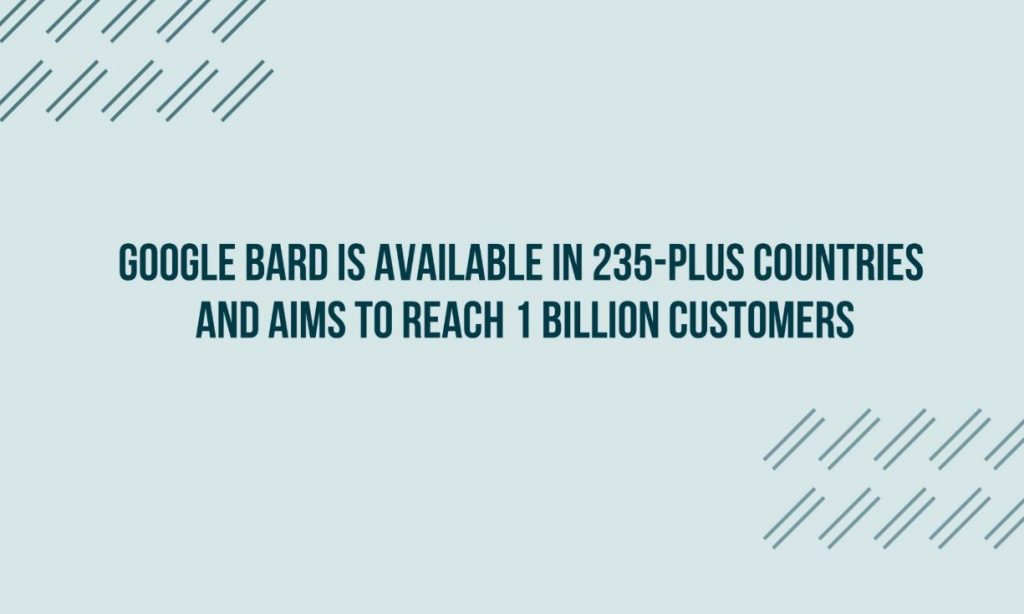
- Currently, 60% of Google Bard's users are male, with the highest age group being 25 to 34 years, comprising 61.35% of male users.
- The United States retains the largest user base at 23%, followed by the India with 9% and Brazil with 5.77% of users.
- During the initial rollout, the average user visit duration was 4.30 minutes, with an average of 2.7 pages visited per session. As of now, Average page visits are 4.65.
- The average visit duration has increased by more than two minutes, recording at 6:37 minutes.
- Bard users come from various occupations, but the most common are students, researchers, and professionals.
- Bard users are interested in a wide range of topics, but the most popular are technology, programming, and news.
- 90.74% of Google Bard's traffic in the United States originates from mobile devices.
- Top searched keywords are bard, google bard, bard ai, bard users, bard statistics and google bard ai.
Top Google Bard Audience Interests Statistics:
- Programming and Developer Software
- Computers, Electronics and Technology
- Graphics, Multimedia and Video
- News and Media
- Video Games Consoles and accessories
How Many Languages Google Bard Supports?
Google Bard now supports 46 languages, including Arabic, Chinese, German, Hindi and Spanish. Here is the list of languages that you can use Bard:
| Arabic | Hebrew | Romanian |
| Bengali | Hindi | Russian |
| Bulgarian | Hungarian | Serbian |
| Chinese (Simplified / Traditional) | Indonesian | Slovak |
| Croatian | Italian | Slovenian |
| Czech | Japanese | Spanish |
| Danish | Kannada | Swahili |
| Dutch | Korean | Swedish |
| English | Latvian | Tamil |
| Estonian | Lithuanian | Telugu |
| Farsi | Malayalam | Thai |
| Finnish | Marathi | Turkish |
| French | Norwegian | Ukrainian |
| German | Polish | Urdu |
| Greek | Portuguese | Vietnamese |
| Gujarati |
General Google Bard Facts and Statistics
- "Bard is named after the Celtic tradition of bards, who were professionals skilled in storytelling, verse-making, music composition, oral history, and genealogy. They were employed by patrons to praise them or their ancestors.
- The name “Google Bard" is a fitting one for Google’s large language model, as it can generate human-like text in response to a wide range of prompts and questions apart from translating languages, writing different kinds of creative content, and answering your questions in an informative way.
- The name “Google Bard" also suggests that Google’s large language model is capable of more than just generating text.
- Google Bard was announced on February 6, 2023, and released on March 21, 2023.
- Initially, it was rolled out to a select group of 10,000 testers.
- Recent updates include enhanced data analysis capabilities, table export to Google Sheets, and expanded access.
- Bard is still under research and development, constantly learning and improving.
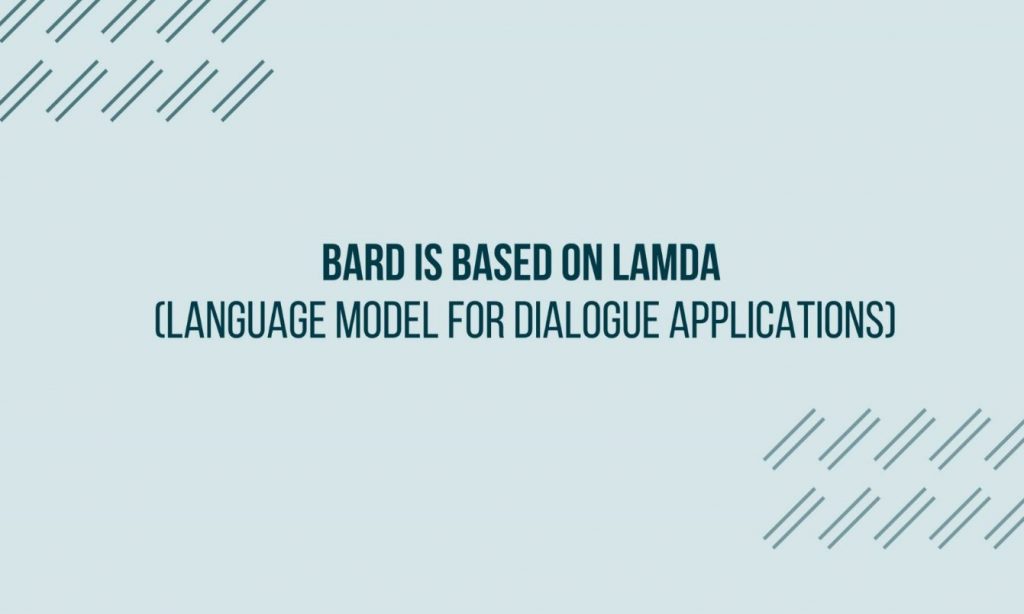
- Bard is based on LaMDA (Language Model for Dialogue Applications).
- LaMDA was announced during Google’s 2021 I/O keynote.
- Google has been working on LaMDA since 2017.
- Bard utilizes LaMDA for engaging and more personalized conversations with users.
- The estimated cost per Bard query is between $0.003 and $0.028.
- Costs can become substantial with a billion users and long conversations.
- LaMDA was trained on the Infiniset dataset. The Infiniset dataset contains around 1.56 trillion words and 137 billion parameters.
- Bard underwent extensive training on a vast dataset comprising text and code from various sources like the web, books, and user-generated content, including search queries and translations.
- Bard boasts a range of functionalities, including question answering, text generation, language translation, creative content writing, and the ability to follow instructions.
- Google Bard AI can assist you in generating various types of content, such as letters, musical pieces, scripts, poems, and code, encompassing various text formats.
- With the installation of the Google Bard AI Chrome extension, users gain access to both traditional Google search results and the added capability of receiving conversational responses.
- As an ongoing development, Bard may occasionally make mistakes and is not equipped to comprehend all types of requests.
- Bard’s promotional video mistake caused Alphabet a $120 billion loss. The incorrect response was related to the James Webb Telescope’s discoveries.
- Bard expands to Docs, Drive, Gmail, Maps, etc. It also works with third-party services and extensions for expanded functionality.
- Integrating AI into search would cost Google from $3 to $6 billion in extra expenses.
- The development and integration of AI-powered search may require a significant investment for Google. The AI-related services are expected to roll out in 2024.
Google Bard's Largest Social Shares
| Social Media Platform | Social Traffic Share (%) |
| YouTube | 54.52 |
| 7.66 | |
| 11.53 | |
| 10.84 | |
| 3.92 | |
| Others | 11.52 |
Bard's Traffic Source Is 'Direct'
As per SimilarWeb, Bard's biggest traffic source is direct, followed by organic and referrals. Below is a table with the percentage share of traffic for each source.
| Traffic Source | Share of Traffic |
| Direct | 80.05% |
| Organic Search | 12.48% |
| Referrals | 2.01% |
| Social | 1.63% |
| Paid Search | 3.01% |
| 0.16% | |
| Display | 0.03% |
Google Bard Technical Details and Statistics
| Feature | Details |
| Model name | LaMDA (Language Model for Dialogue Applications) |
| Training dataset | Infiniset, a massive dataset of text and code |
| Number of parameters | 137 billion |
| Capabilities | Can generate text, translate languages, write different kinds of creative content, and answer your questions in an informative way |
| Availability | Official release on February 6, 2023
Public access granted on March 21, 2023 |
| Cost per query | Base search cost of approximately $0.003 per query ranges from $0.003 to $0.028. |
Infiniset Dataset Composition
The Infiniset dataset, used to train Google Bard, consists of the following sources:
| Dataset Source | Percentage in Infiniset |
| C4-based data | 12.5% |
| English language Wikipedia | 12.5% |
| Code documents from programming Q&A websites, tutorials, and others | 12.5% |
| English web documents | 6.25% |
| Non-English web documents | 6.25% |
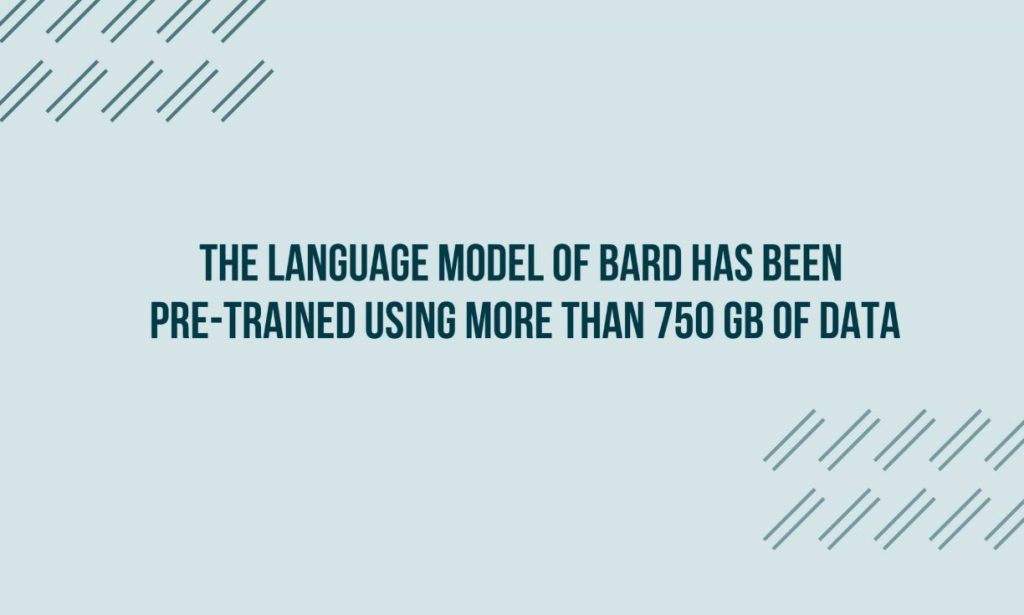 For the training of Google Bard’s LaMDA model, the Infiniset dataset serves as an invaluable resource. This dataset boasts an astonishing compilation of 1.56 trillion words and is built upon a staggering 137 billion parameters. Accommodating such an enormous amount of information requires a storage space of 750 GB. Despite its size, the Infiniset dataset proves to be an ideal training platform for the LaMDA model, enabling it to gain a vast pool of knowledge and adaptability, ultimately enhancing its performance across a wide range of applications.
For the training of Google Bard’s LaMDA model, the Infiniset dataset serves as an invaluable resource. This dataset boasts an astonishing compilation of 1.56 trillion words and is built upon a staggering 137 billion parameters. Accommodating such an enormous amount of information requires a storage space of 750 GB. Despite its size, the Infiniset dataset proves to be an ideal training platform for the LaMDA model, enabling it to gain a vast pool of knowledge and adaptability, ultimately enhancing its performance across a wide range of applications.
Eligibility To Use Google Bard
Individuals need to be 18 years or older and possess a personal Google account. The service is currently accessible in 235+ countries and territories.
Limitations of Bard
Like all AI chatbots, Google Bard faces certain limitations. During its initial demo, it was evident that Bard requires continuous learning and training to provide accurate responses and differentiate between reliable and misleading information. AI training is an ongoing and computationally intensive process due to the perpetual influx of new information and data.
Here are some limitations:
Bias, Inaccurate, and Ambiguity:
- Scope of providing biased, inaccurate, and ambiguous information.
- Trained on data that may contain bias, leading to misleading responses.
- Sometimes provides vague responses due to a lack of context understanding.
- Users may need to fact-check the information obtained.
Limited in Creativity:
- Tends to produce repetitive and unoriginal responses.
- May generate content similar to existing works.
Does not provide a Source:
- Doesn’t cite or provide links to the sources of information.
- Not suitable as an independent tool for research purposes.
Inconsistencies in Responses:
- May claim certain abilities but fail to perform when tested.
- Lacks the ability to read or understand documents.
Limited Generative Potential:
- Restricted in producing lengthy content, such as articles or essays.
- Falls short compared to AI tools like GPT-4.
Developmental Stage:
- Operational limitations and inefficiencies to be expected.
- Flaws and limitations despite advanced potential.
How To Export Responses from Bard?
Bard offers a convenient feature that allows users to export their responses and tables to various Google products, facilitating seamless integration and further collaboration. It’s important to note that when you export content from Bard, the terms and policies of the destination service will apply to the exported content.
Exporting Bard Responses to Google Docs:
You can use Google Bard in Google Docs and Google Sheets. Here are the steps to follow:
- Beneath the response, locate and click on “Share & export."
- Choose “Export to Docs."
- This action creates a new document in your Google Drive, containing the exported content.
Exporting Bard Answers to Gmail:
You can export the Google Bard responses using Gmail. Here are the steps to follow:
- Below the response, find and click on “Share & export."
- Select “Draft in Gmail."
- This generates a draft email within Gmail, populated with the exported content.
Exporting Bard Tables to Google Sheets:
If a Bard response includes a table, you can export it to Google Sheets for further analysis or manipulation.
- Find the table within the response.
- Click on “Export to Sheets," typically located at the bottom right of the table.
- A new spreadsheet in your Google Drive will host the exported table. Please note that tables containing images cannot be exported to Sheets.
Gmail Account Requirement:
Please keep in mind that this export feature is exclusively available to users with a Gmail account.
Google Workspace Considerations:
For users signed in to a Google Workspace account, the availability of export options may vary based on Workspace settings and current feature availability.
Google Bard Advantages
1. Built on Cutting-edge Model (PaLM):
- Google Bard is based on the state-of-the-art model, PaLM2, which offers advanced multilingual capabilities, improved coding abilities, and enhanced reasoning.
- Trained on vast datasets, including open-source repositories, social media conversations, Wikipedia articles, books, and news articles.
- Empowers Bard with generative and problem-solving abilities.
2. Conversational Human-like Responses:
- Google Bard utilizes natural language processing to understand text prompts and provides human-like conversational responses.
- Acts as a chatbot, answering queries and responding to instructions.
3. Translation Capacity:
- Google Bard can translate over 100 languages, facilitating smooth communication and content reading in various languages.
- Some of the most popular languages used include English, Spanish, German, French, Chinese, Japanese, etc.
4. Compatible with Voice Commands:
Features a microphone option for processing voice commands, providing a competitive edge over other tools like Open AI’s Chat GPT.
5. Specific Generative Potentials:
Core feature of text generation, producing content in various styles and formats such as news articles, letters, blog posts, essays, email messages, and creative writing.
Capable of generating and debugging codes in multiple programming languages.
6. Provides Real-time Information and Internet Access:
- Utilizes Google search to provide the latest and up-to-date information in real-time.
- Ideal for researchers and anyone seeking reliable and relevant information across diverse topics.
7. Extensions Through Plugins:
- Bard offers extensions through plugins, enabling users to use its features in other apps and sites like Adobe, Spotify, YouTube, etc.
- Allows for streamlined control, video watching within the chat interface, booking recommendations, and image generation using prompts.
8. User-friendly:
- Boasts a user-friendly interface, making it easy to use and understand for Google users.
- Integrates seamlessly with Google products and services.
How To Use Google Bard – A Guide to Maximizing its Potential
Google's extensive experience with Language Model Models (LLMs) has emphasized the importance of empowering users to comprehend and manage the limitations of an LLM while harnessing its capabilities to the fullest. As you explore Bard, you will encounter several purposeful choices that the company is experimenting with. Below, we outline some of these features:
Multiple Drafts:
Bard has the remarkable ability to generate various responses, even when given the same or similar prompts and questions.
Early testing has revealed that users appreciate the option to view different responses, particularly in cases involving creative prompts like poems or short stories, or when there is no definitive right answer.

By selecting “view other drafts," users can access multiple drafts of Bard’s responses and choose the one that aligns best with their preference.
“New Response":
If you desire to see a different set of responses, you can request Bard to generate a new response.
This feature proves useful in situations where Bard may have misinterpreted instructions or produced lower-quality responses.
Additionally, it allows users to have Bard reattempt its response to the same prompt.
“Google It":
Bard is equipped with a “Google it" button, providing users with an effortless way to verify its responses or explore further sources on the web.
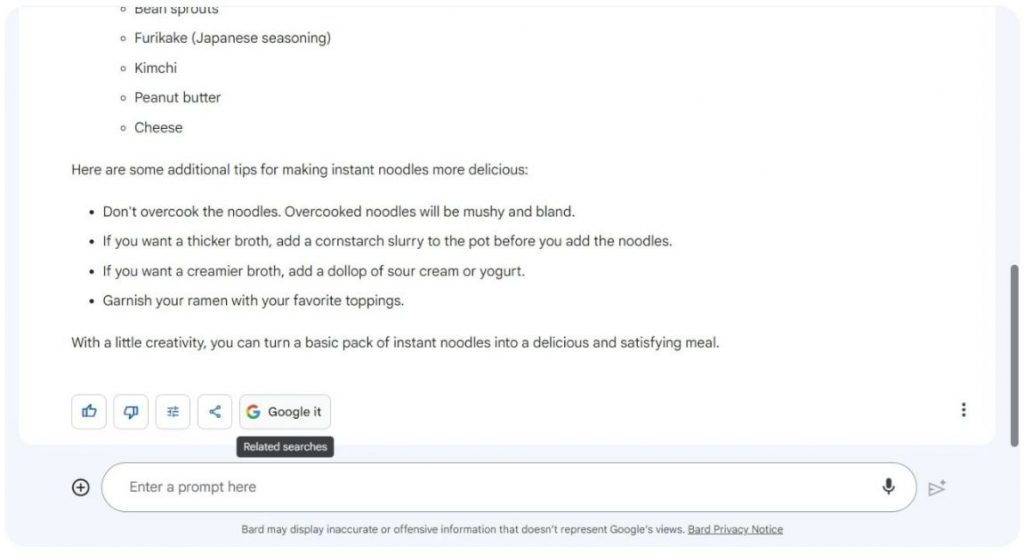
By clicking “Google it," Bard offers suggestions for relevant Google Search queries.
Upon selecting a query, Google Search opens in a new tab, enabling users to cross-reference Bard’s responses or conduct additional research.
Citations:
As with other standalone LLM-based interfaces, Bard generates original outputs based on its prediction mechanism.
In some cases, Bard’s responses may reference existing content.
If Bard extensively quotes from a webpage, it provides citations to help users easily access the source and learn more about the topic.
Other Interesting Bard Features
- New Chat
- Pinned & Recent Threads
- Upload File / Google Lens in Bard
- Share Bard Conversations with Others via Link
- Modify Bard's Responses
- Export Python Code to Replit
- Export Bard-generated Tables to Google Sheets
Google Bard: Shaping the Future of AI Search
Sundar Pichai, the Chief Executive Officer of Google, recently confirmed that Google Bard is set to play a pivotal role in AI Search and will be integrated into various products in the near future. Although Google Bard is still under development, its potential as a powerful tool for businesses, students, and individuals is evident.
Potential Applications of Google Bard:
- Businesses: Google Bard could revolutionize marketing efforts by generating compelling copy and product descriptions. It could also create efficient customer support chatbots. Additionally, Bard’s capabilities in research and development could provide businesses with innovative ideas and concepts for new products and services.
- Students: Embracing Google Bard can significantly aid students in their studies. It can offer concise summaries of complex subjects, generate practice problems, and even assist in crafting well-structured essays. Furthermore, Bard could facilitate language learning by providing translations and usage examples.
- Individuals: Google Bard is a versatile tool for personal projects, providing creative brainstorming ideas, crafting outlines, and generating content. It can also serve as an efficient assistant for everyday tasks, offering information, answering queries, and making reservations.
Challenges and Future Developments:
Despite its potential, Google Bard must overcome certain challenges to fully realize its capabilities. One significant hurdle is improving its accuracy and reliability, as occasional errors may deter potential users. Additionally, enhancing affordability is essential to increase its adoption, as the current non-free nature of Bard may limit its accessibility.
The Road Ahead for Google Bard
Google Bard is poised to become even more integrated with various Google products and services. For instance, it might be leveraged to create content for Google Docs, facilitate language translation in Google Translate, and provide answers in Google Search. According to reports, the platform aims to reach a staggering 1 billion users by 2025, representing an impressive milestone in its journey.
We express our gratitude to all readers for engaging with this comprehensive blog post and invite you to stay connected with us for more informative content in the future.
Google Bard FAQs:
Can I access Google Bard AI?
Yes, Google Bard is open for access to all. Although initially limited to the US and UK with a waitlist, Google’s AI chatbot, Bard, is now readily available in a majority of global regions.
When was the launch date of Google Bard AI?
Google Bard AI was launched on March 21, 2023.
Why is Google AI called Bard?
The name “Bard" for Google AI is derived from the term “Poet," associated with the renowned English literary figure William Shakespeare, known as the Bard of Avalon. Beyond its poetic connection, “Bard" also serves as an acronym representing “Language Model for Dialogue Applications," which Google employs as its language model.
Is there a Google Bard app?
No, Google Bard does not currently offer any app for mobile or desktop usage.
What are the new languages added to Bard?
The newly added languages for Google Bard include Spanish, French, German, Italian, and Mandarin Chinese.
Which countries has Bard recently expanded its access to?
Bard has extended its access to additional countries, now covering all 27 EU nations and Brazil.
How many programming languages could Bard initially work with?
In April, Bard acquired coding assistance capabilities, initially supporting over 20 programming languages.




